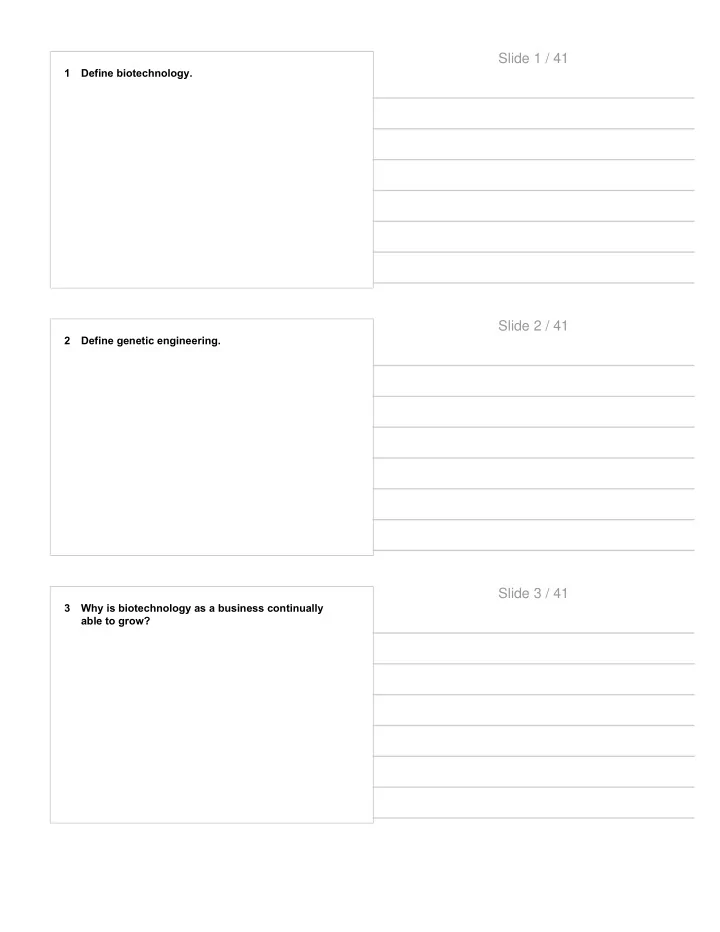

Slide 1 / 41 1 Define biotechnology. Slide 2 / 41 2 Define genetic engineering. Slide 3 / 41 3 Why is biotechnology as a business continually able to grow?
Slide 4 / 41 4 Define cloning. Slide 5 / 41 5 What type of technology has been widely used for cloning animals? Slide 6 / 41 6 Define stem cells.
Slide 7 / 41 7 Identify two different types of stem cells. Slide 8 / 41 8 Identify some of the common examples of biotechnology. Slide 9 / 41 9 What was the first animal to be cloned?
Slide 10 / 41 10 What was the first mammal to be cloned? Slide 11 / 41 11 Describe the steps of nuclear transfer cloning. Slide 12 / 41 12 What advantage do embryonic stem cells have over adult stem cells?
Slide 13 / 41 13 Describe how embryonic stem cells have been used to date. Slide 14 / 41 14 Describe how adult stem cells have been used to date. Slide 15 / 41 15 What is diabetes?
Slide 16 / 41 16 Identify the technology that allowed for production of human insulin. Slide 17 / 41 17 Briefly describe how the human insulin was produced. Slide 18 / 41 18 How are pieces of DNA found on the genome today?
Slide 19 / 41 19 The sites where the restriction enzymes cut the DNA are known as what? Slide 20 / 41 20 Describe what causes the DNA to move through the gel. Slide 21 / 41 21 How was diabetes first treated? Explain why this was not successful.
Slide 22 / 41 22 List the steps of Recombinant DNA Technology. Slide 23 / 41 23 Which macromolecule allows for genetic engineering to occur? How? Slide 24 / 41 24 Describe how we are able to separate the gene of interest from the genome.
Slide 25 / 41 25 Which pieces of DNA would be found farthest from the starting point in a gel electrophoresis? Slide 26 / 41 26 After we separate the gene of interest through gel electrophoresis, what is the next step in Recombinant DNA Technology? Slide 27 / 41 27 After PCR, what happens to our gene of interest?
Slide 28 / 41 28 Identify the part of the bacteria where the gene of interest can be inserted. Slide 29 / 41 29 Provide examples of common uses for Recombinant DNA technology. Slide 30 / 41 30 What is the end product of PCR?
Slide 31 / 41 31 How is the gene of interest able to insert itself within the host DNA in the correct location? Slide 32 / 41 32 What enables bacterial cells to be able to reproduce and express this gene that is newly introduced to this organism? Slide 33 / 41 33 Identify the last step of Recombinant DNA technology.
Slide 34 / 41 34 Define gene therapy. Slide 35 / 41 35 Differentiate between the view of genetic engineers and synthetic biologists. Slide 36 / 41 36 How is this synthetic life different from the original bacteria cell?
Slide 37 / 41 37 Explain the importance of a DNA synthesizer. Slide 38 / 41 38 List the steps of gene therapy. Slide 39 / 41 39 Briefly explain the process of creating a synthetic life.
Slide 40 / 41 40 What is the scientific hope for the creation of synthetic life? Slide 41 / 41 41 What is the major controversy surrounding the ethics of biotechnology?
Recommend
More recommend